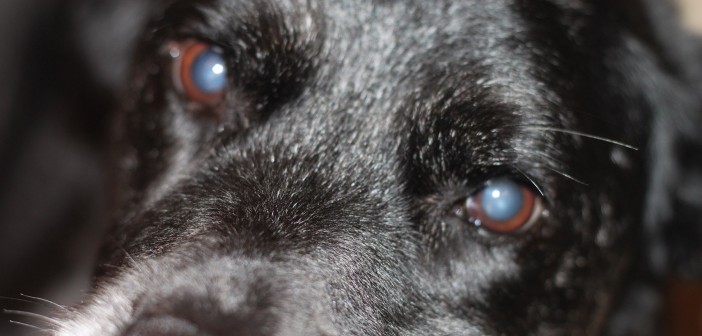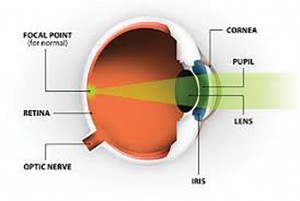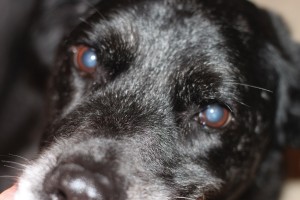At about the age of seven, most dogs begin to develop a subtle change in the appearance of their eyes. The lens of the eye — what we see as the pupil — starts to take on a slightly blue or milky appearance. Owners often assume that this change indicates that their dog is developing cataracts. While dogs may certainly develop cataracts, they much more commonly develop a condition called nuclear sclerosis, sometimes called lenticlular sclerosis.
The eye is a very precise organ. Light first enters the eye through the cornea; it is then focused by the lens onto the retina. For vision to be perfectly clear, the cornea and lens must be perfectly transparent. Anything that affects the transparency of these structures affects the eye’s ability to generate a clean, clear image. While cataracts and nuclear sclerosis both have an effect on vision, the effect of cataracts is dramatic while that of nuclear sclerosis is less significant.
What is a cataract?
A cataract occurs when the lens becomes opaque. The area of opacity can involve the entire lens or just part of the lens. The cataract scatters the light as it passes through the lens, preventing the lens from focusing the light clearly onto the retina. If the cataract involves the entire lens, then that eye will only be able to see light and dark; if it involves just part of the lens, then that area becomes a blind spot in the visual field.
When an ophthalmoscope is used to examine the eye of a dog with cataracts, the retina at the back of the eye cannot be seen clearly. A cataract obscures vision the same way a thick layer of ice obscures your ability to see out of a car’s windshield — you can look out the windshield and see light and shadows, but you can’t see much else.
In dogs, cataracts have several causes. Diabetes is the most common cause of cataracts involving the entire lens, and nearly all diabetic dogs end up developing cataracts. Other causes of cataracts include hereditary causes, trauma to the eye, chronic inflammation in the eye, and age-related degenerative changes to the lens.
Is there a treatment or preventive for cataracts?
If an underlying disease that is known to cause cataracts is diagnosed (such as chronic inflammation of the anterior chamber of the eye, or anterior uveitis), effective treatment of the disease can prevent cataract formation. A medication is currently undergoing testing for the prevention of diabetic cataracts, but data on the efficacy of the medication is still being collected, and the medication is not available to the general public.
Currently, no medication treats cataracts once they have formed. The only treatment for cataracts is to remove the lens. Cataract removal is a very technical surgery and is performed by veterinary ophthalmologists Unfortunately, unlike with people, veterinary patients generally undergo cataract surgery after their cataracts have completely matured and they are totally blind. Surgery is much more difficult and technical at this point and requires the expertise and experience of a specialist.
What is nuclear sclerosis?
Nuclear sclerosis simply means hardening of the lens. The body of the lens is made up of carefully arranged protein fibers. As the lens ages, it produces more of these fibers. Since the lens expands very little, these fibers become more densely compacted with age. This changes the refractive properties of the lens that results in the pupil taking on a cloudy or milky appearance. These changes have a small effect on the transparency of the lens. When an ophthalmoscope is used to examine an eye affected with nuclear sclerosis, the back of the eye, the retina, can be clearly seen.
Does nuclear sclerosis need to be treated?
Nuclear sclerosis affects vision. Dogs may have a more difficult time focusing on small objects in low light. They may have a harder time finding a treat that has been dropped on the floor or negotiating a step down when going outside at night. This has little effect on a dog’s ability to perform daily tasks because dogs do not rely on precise visual acuity — they don’t need to be able to read a newspaper or drive a car. Since dogs function well with nuclear sclerosis, the condition does not generally need to be treated.
If you are worried about your dog’s vision, have our veterinarian evaluate his vision and examine his eyes.
By: Jess Anderson, DVM
Dr. Anderson is a veterinarian at Timpanogos Animal Hospital in Pleasant Grove, Utah. His professional interests include dentistry, surgery, and internal medicine. Besides dogs, cats, horses and cattle, Dr. Anderson has worked with sheep, goats, llamas, alpacas, and pigs and even had one run-in with a water buffalo.






